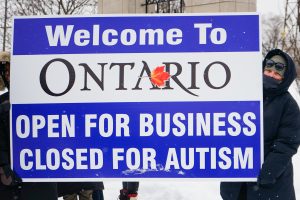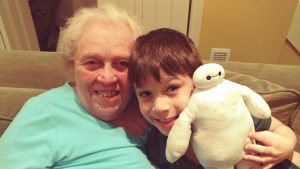Autism controversy for the uninitiated- part one
The Ford government has just dropped an enormous bomb on the Ontario Autism program, blown it to bits and rendered it useless. The funding cuts to children requiring therapy and those currently receiving help are so huge that most of them will no longer receive the treatment they need. If families can no longer access therapy, upwards of 10,000 autistic children will be thrust into the public education system which is completely ill-equipped to cope with them.
Until I became a grandmother, I knew next to nothing about autism. I think it’s true for most of us that unless we’ve had life experience with disability, our knowledge and understanding is limited. My aim in this set of short articles is to outline the current controversy swirling around Ontario where families struggling with autism are pitting themselves against the Ford government. I’m no expert. I only write from our family’s experience. My hope in relaying our story is to piece together the recent events and multiple issues faced by families coping with autism. Human rights and the public education system are front and centre in this story.

Funding the Treatment for Autism:
Waiting lists are not the greatest injustice faced by parents of autistic children. The current government is using the wait list issue to distract from a much larger one- funding for the actual therapy. My grandson’s Applied Behavior Analysis (ABA) therapy costs $55.00 per hour for a 30 hour week. The weekly bill is approximately $1, 650 per week or $85, 000 per year. That money came from the province’s Ontario Autism program. It stops in April.
In 2016 the Liberal government of Ontario earned the wrath of parents in the province by cutting off all funding for therapy for autistic children over the age of five. Thousands of kids were to be turned away from therapy- and the wait list too- with no other prospect than the public school system before them. Faced with a furious parental backlash and public shame, the Wynne government backed down. It abandoned its reforms to the Ontario Autism Program.
But it had no Plan B. Close to a general election and desperate to dissipate the angry clamour, the government awarded every child with an autism diagnosis $8 000 to $10 000 per month. It could be used to pay a private provider or in one of the government sponsored Direct Service organizations. Over time those children were folded into the newly created Ontario Autism program and that $8 000 to $10, 000 monthly funding dissolved.
Enter the Ford government. While in opposition the Tories enthusiastically supported the autism families’ protests. Once in office, they reversed their position offering families only $20, 000.00 annually for a child under age six and $5,000 a year for children aged six and over. Nobody was fooled. Full time therapy costs $60, 000 to $80, 000.00 per year regardless of age. Then they capped the funding at $140 000 over the child’s life up to age 18. On top of that, any family with an income of $55 000 per year -that’s a family with two minimum wage parents- will face a claw-back.
The first three to four weeks of any therapy program is a period of assessment. It takes a lot time to assess each new child’s abilities, preferences and behaviors before therapy can begin. The $20 000 will barely cover a child’s assessment period. Families with older children will run out of money long before their assessments are complete.
The wait list
There are over 23 000 children diagnosed with autism waiting for therapy. Some have been waiting for nearly four years. A diagnosis is essential to access therapy. The diagnosis itself may take some time- upwards of two years or more especially if the family lives in Northern or rural Ontario. Then, with a diagnosis in hand, an Ontario family has a long wait before a space opens. The reason for this is a critical shortage of qualified ABA practitioners. No amount of money thrown at the Ontario Autism program is going to make any difference if there aren’t enough professionals to meet the number of kids needing help. There is a massive need in northern and rural Ontario where there is next to no service at all.
Two successive Ontario governments have tried to deal with this wait list by introducing age cutoffs for service. But cutoffs will do nothing to alter the number of autistic children in Ontario requiring services and only serve to outrage families who have waited patiently in line only to see their child disqualified. We know 90% of human brain growth and 85% of the brain’s nerve pathway development occurs before age 5. Naturally everyone is anxious for early intervention. But to cut off therapy to kids aged six and over to reduce the numbers on the wait list is grossly unfair.
So there are two bottlenecks in the way to early intervention: one is getting a diagnosis; the other is the capacity for the province to deliver ABA therapy. A consistent, standardized report form from physicians would go a long way to alleviate confusion caused by the volume and variety of “prescription pad” diagnosis or self-referrals. The scarcity of ABA therapists, board certified behavior analysts (BCBAs) and psychologists who specialize in autism has to be addressed. If the number of specialists does not increase there will be a long wait list no matter how the money is distributed.
What is autism?

Autism is a brain development disorder and a lifelong condition. No one knows what causes it and there is no “cure.” It is also known that there is a range of severity in the disorder and this is why it’s referred to as a spectrum. Autism Spectrum Disorder, its formal name, makes its presence known early in life. The red flags usually appear around 10 to 24 months in age. More boys are diagnosed than girls at a rate of three to one. However, there are experts who are now telling us that girls can present symptoms a little differently from boys and therefore can go undiagnosed. One child in 66 children will be somewhere on the autism spectrum. There are about 40,000 children in Ontario between the ages of three and 18 who have been diagnosed with autism. There may be as many as another 40,000 who are undiagnosed.
Many children with autism show very early in life that communication and social interaction skills are extremely slow in developing. Some examples of this can be little or no eye contact; children may appear as if they do not look at or listen to others. For example, my grandson did not respond if I called his name or tried to draw his attention to something. There was no chit chat or back and forth conversation. He rarely shared his enjoyment in objects or activities unlike other kids who will point to or show you the things they’re engaged in. I’ve learned that some children don’t seem to be able to see another person’s point of view or how they are feeling. They can’t read body language. Their own gestures and facial expressions may not match what they’re saying.
There are also behavior indicators. Some children on the spectrum are very repetitious. They may repeat words and phrases over and over- a behavior called echolalia. They may shake their hands or jump up and down as if to get rid of excess energy- a behavior called stimming. They often take an intense often obsessive interest in certain things, topics or details- numbers, license plates, subway stations. They can be overly sensitive to certain sensory input- sounds, lights, texture in certain fabrics. Many have sleep problems. Many have unusual strengths in areas such as math, music, science and art. Some famous people who might have been on the spectrum include Mozart, Albert Einstein and Glen Gould.
Charlie
Meet my nine-year old grandson, Charlie. Before age three he knew the alphabet and loved arranging the letters in order. I recall pushing his stroller down the street while he enthusiastically called out all the house numbers. At three he could count to 100 by twos and fives. By four he could read. No one taught him; he just figured it out. But at age 6 he was not fully toilet trained and still wearing a diaper at night. He refused to sleep in his own bed and couldn’t sit at the dinner table for more than a few minutes. He did not speak in sentences- only in single words and phrases- mostly to indicate what he wanted at the moment. If something caught his interest, he would bolt for it. Calling his name loudly and sharply had no impact whatsoever. Someone had to grab him.
Safety was a huge issue. His parents only took him into a store if they were both in attendance. While one parent did the shopping, the other chased Charlie up and down the aisles as he excitedly called out numbers he saw on the signs and advertisements. He developed a fascination with elevators. He still has to ride every one he comes across and no one can spot an elevator faster than Charlie. He could never abide public address systems. Taking him into stores, airports or a subway station risks a melt-down.He will turn off any TV, radio or background music that’s playing when he enters the room. The ringers on our phones had to be shut off to keep him calm. He developed crippling phobias- such as a fear of men- that debilitated him.
My daughter, Charlie’s mom, knew something was amiss before his first birthday. By 18 months, she clearly saw his red flags and had a fair inkling that he might be autistic. She called the pediatrician and after a few false starts finally got Charlie into the lineup for a diagnosis at Holland Bloorview Hospital. After waiting two and a half years, Charlie was diagnosed just before his fourth birthday. His diagnosis made him eligible for ABA therapy. In the meantime his mother enrolled him in Holland Bloorview nursery school and after a year he attended a diagnostic junior and senior kindergarten in Scarborough. Finally, just after his sixth birthday and after waiting another two and a half years, Charlie was eligible for funding and got into an ABA therapy program. Two months later, in the spring of 2016, the Ontario government pulled funding for ABA therapy out from under every child in the province over the age of five. Charlie was cut off after waiting most of his life for needed treatment.
My daughter engaged a Speech Language Pathologist at a cost of $180 per hour. This is not a publicly funded service. She and her husband have spent over $43, 000 in five years on speech therapy alone. Eighty percent of that cost has been recouped by my son-in-law’s insurance through his employer. The vast majority of families are not so lucky. There are numerous other costs as each community activity requires the engagement of 1:1 support at a cost to the family. My daughter has left the workforce to accommodate Charlie and drives 60 000 kms per year to take him to his therapy appointments since their family lives in a “service desert” and there are no centres or other therapies in her area that can accommodate Charlie.
What is ABA therapy?
So what is this ABA therapy parents want so their children will develop communication skills and to modify some of their socially inappropriate behaviors? I am not an expert, but here is what I have learned. It’s called Applied Behavior Analysis (ABA) and sometimes Intensive Behavior Intervention (IBI.) It’s been

around for about 40 years and it’s been proven effective. It is an evidence-based, scientific method that uses focused interventions. It targets a specific skill deficit and or one or more behavior excesses at a time. The interventions are time-limited and implemented until the goal is achieved. IBI or comprehensive ABA by another name includes the essential practice elements of ABA but in a very intensive and comprehensive manner. So what’s the problem? It’s expensive and there are too few practitioners.
The changes in Charlie after three months of ABA were immediate. Gone was the diaper. He could rinse and spit. Up until then, you couldn’t approach him with a toothbrush. Consequently his teeth were decaying. He required 7 baby root canals and an extraction at Sick Kids Hospital. A few weeks into his program he could remove his outer clothing, put it away with his backpack and boots into his cubby. He was speaking in simple sentences, answering questions and even showing signs he was willing to negotiate for things he wanted. All these accomplishments and others were being carefully charted by his instructor therapists, as they are called.
In order to teach a skill, like tying one’s shoe laces, the process is broken down into very small manageable tasks. The first might be to judge which shoe goes on what foot. Next, sit on the floor and put each shoe on the correct foot. Great. That’s enough for today. When the child shows a successful completion of these tasks, then it’s recorded and it’s on to the next step. It might take two days or two weeks or many months to tie those shoes.
In intensive programs, many skills are worked on and a good centre will also prioritize which goals are attainable in consultation with parents. The aim is to move the child along, so they feel proud of themselves and not to grind in skills. With each successful completion, there is a little reward. In Charlie’s case, it was his one chance to operate the centre’s office machines or play in the gym on the swings. Those were his choices. If he had been really successful, he was allowed to print five pages. If he had worked really hard to achieve something new, he got to shred five pages. This was a huge deal for a little boy who can’t pass up any electronic device or resist pushing any button- especially if there’s a light on it.
ABA therapy has been proven effective for kids with disabilities other than autism. It has been successfully used to help kids who’ve suffered brain damage, fetal alcohol syndrome, multiple physical/ mental disabilities. But it’s expensive. One trained and Board Certified Behaviour Analyst (BCBA) teacher to one student for 30 hours a week costs a lot more than a day in junior kindergarten. In a well-run centre, a child will work with several instructor therapists in the course of a day. A senior therapist takes a turn with each child and co-ordinates a program with the instructors. Progress or the lack of it is thoroughly recorded and reviewed by a clinical psychologist. But it’s the proven difference between learning and languishing in a regular public school classroom where no one has the knowledge, the training or time to help. It’s intensive and expensive but it works.
When should therapy end? Who decides? A qualified clinical psychologist supervising the child’s therapy team should be the one to decide when a child is ready to integrate into the school system. But then the schools have to be ready to receive them.

Here’s my grandson Charlie working with his senior therapist after one year receiving intensive ABA therapy.
Janet Bojti retired after 25 years teaching ESL to adults in the Continuing Education Division of the TDSB. She is a an active supporter of the Campaign for Public Education and the Toronto Educational Opportunity Fund which fundraises for nutrition programs in schools in Toronto’s neediest neighbourhoods

